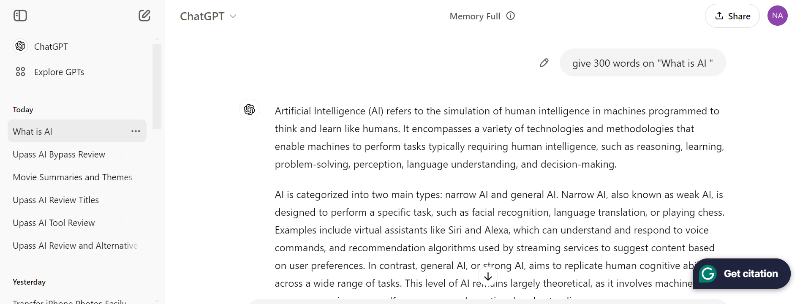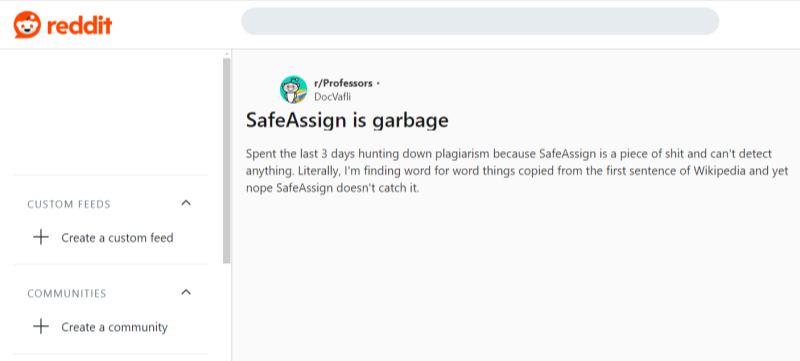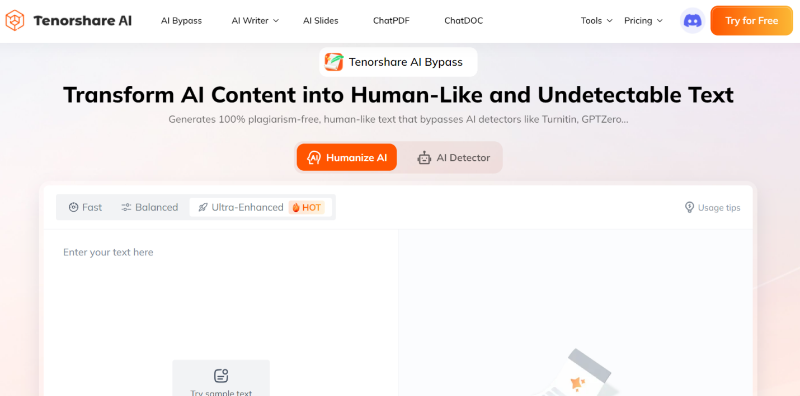SafeAssign Plagiarism Checker: An In-Depth Review of Its Effectiveness
SafeAssign was once a key tool for checking plagiarism in academic and professional work, but its reputation is fading with new technologies, especially AI. Although many schools and businesses still use it, users are raising concerns about its accuracy, ease of use, and ability to catch more advanced forms of plagiarism.
With my solid experience in testing a range of AI detection tools such as Turnitin, ZeroGPT, and Copyleaks, I conducted several trials to evaluate the reliability of SafeAssign plagiarism checker. Let’s dive into this review:
Part 1: What is SafeAssign?
SafeAssign plagiarism checker operates by comparing submitted content to a large repository of academic papers, institutional archives, and publicly accessible databases. It includes websites and other publications available online. The tool generates a report detailing the percentage of text that matches content found in its database.
Key Features of SafeAssign:
- Database Comparison: SafeAssign matches submitted work with a range of academic papers, journals, and websites.
- Plagiarism Percentage: It provides a detailed report showing the percentage of the text that may be plagiarized.
- Submission Tracking: SafeAssign keeps track of multiple submissions from users, often allowing for re-submission within academic guidelines.
Pros & Cons of SafeAssign
Pros:
- Effective at detecting word-for-word plagiarism from sources within its database.
- Provides detailed plagiarism percentage reports.
- Tracks multiple submissions, allowing users to resubmit work.
- Widely used in academic institutions.
Cons:
- Struggles to detect paraphrased and AI-generated content.
- Limited database, missing obscure and newer sources.
- Prone to false positives, flagging common phrases as plagiarism.
- Slow report generation, especially during peak usage times.
Part 2: Personal Experience with SafeAssign
In my experience, SafeAssign plagiarism checker fell short of expectations. The tool often flagged common phrases and citations as plagiarism, leading to inaccurate reports that required time-consuming manual checks. Its limited database missed more obscure sources, reducing its effectiveness in detecting subtle forms of plagiarism. Overall, I found SafeAssign plagiarism checker unreliable for thorough plagiarism detection. For further verification I also get info from different forums

Reddit User Feedback on SafeAssign
Many Reddit users have expressed frustration with SafeAssign plagiarism checker, frequently labeling it as "garbage" due to its inaccurate detection and tendency to flag common phrases or properly cited sources.

Quora User Feedback on SafeAssign
Quora users have similarly criticized SafeAssign plagiarism checker, with many noting its inefficiency in detecting genuine plagiarism. Some users have reported that the tool misses significant portions of copied content while flagging innocuous or commonly used phrases.

SafeAssign plagiarism checker has proven unreliable, often flagging common phrases and missing obscure sources, leading to time-consuming manual checks. Reddit and Quora users share similar frustrations, criticizing its inaccurate detection and inefficiency in identifying genuine plagiarism. Overall, it struggles to provide thorough plagiarism detection, especially in more complex cases.
Part 3: Testing SafeAssign: Strengths and Limitations
Here’s a closer look at how it performs.
Accuracy in Detection
SafeAssign plagiarism checker does reasonably well in detecting word-for-word plagiarism, especially when the source material exists in its database. When content is lifted verbatim from online or academic sources, SafeAssign usually flags it effectively. However, its performance drops significantly when it comes to more sophisticated forms of plagiarism, such as paraphrasing or patchwork plagiarism.
Over-Reliance on Database Matching
SafeAssign’s reliance on its existing database is another major limitation. While its database is extensive, it is not comprehensive. It struggles to detect plagiarism from sources not included in its repository, especially newer or niche sources, as well as AI-generated content, which often isn't part of the traditional academic databases.
False judgement
Another issue users frequently encounter is SafeAssign’s tendency to flag non-plagiarized content as plagiarized. This occurs when common phrases or standard academic terminology are identified as potential plagiarism.
Slow Turnaround Time
SafeAssign plagiarism checker report generation process can be slow, particularly during peak usage times, such as exam periods or project deadlines. Students and educators alike have expressed frustration over the delay in receiving reports, especially when timely feedback is crucial.
Part 4: Growing Challenge: AI-Generated Content
With the rise of AI writing tools such as ChatGPT, Jasper, and others, the landscape of content creation has changed dramatically. Here the some challenges:
- AI-generated content is increasingly used in academic papers, professional reports, and creative writing.
- SafeAssign was not designed to detect AI-generated content effectively.
- Traditional plagiarism detection tools rely heavily on database comparisons.
- These tools have not evolved to handle the complexity of AI-generated text.
- This creates a serious challenge for institutions relying on SafeAssign to ensure content originality.
SafeAssign’s Struggle with AI-Generated Content
SafeAssign falls short when it comes to identifying text generated by AI. Since AI-generated content is not typically part of the traditional academic or public databases that SafeAssign uses, it flies under the radar. As AI tools become more prevalent, this inability to detect AI-generated content severely limits the effectiveness of SafeAssign in modern content detection.
Part 5: Introducing Tenorshare AI Bypass: A Modern Solution
In an age where AI-generated and paraphrased content is increasingly common, traditional tools like SafeAssign plagiarism checker are struggling to stay relevant. Enter Tenorshare AI Bypass, a paraphrasing tool designed to help users create unique content without detection from traditional plagiarism or content-matching software. Tenorshare AI Bypass is not a plagiarism detector, nor does it check for copied content. Instead, it is a powerful paraphrasing tool that allows users to rework their text in a way that avoids detection by tools like SafeAssign.

Features of Tenorshare AI Bypass
- Focus on Paraphrasing: Unlike plagiarism checkers, Tenorshare AI Bypass is specifically designed for paraphrasing; ensuring that content remains original without raising flags in content-matching software.
- User-Friendly Interface: The tool provides an intuitive and easy-to-use interface, making it accessible for users of all skill levels.
- Enhanced Content Creation: Users can generate unique, high-quality content quickly, improving their writing efficiency and effectiveness.
- Versatile Applications: Ideal for students, content creators, and professionals who need to produce original work without the risk of plagiarism.
- Future-Ready Solution: Tenorshare AI Bypass positions itself as a forward-thinking tool that adapts to the evolving landscape of content creation and plagiarism detection.
- Integration and Compatibility: The tool can easily integrate into various workflows, enhancing productivity without disrupting established processes.
How Tenorshare AI Bypass Outperforms SafeAssign:
| Feature | SafeAssign | Tenorshare AI Bypass |
|---|---|---|
| Bypassing Detection Systems | Flags well-reworded content as plagiarized, focusing mainly on database comparison. | Intelligently paraphrases content to avoid detection, offering more flexibility. |
| Handling Complex Paraphrasing | Struggles to detect intelligently reworded content. | Excels at ensuring paraphrased content is not easily recognized as a duplicate. |
| Enhanced Flexibility | Rigid system with limited ability to process paraphrased text. | Provides greater flexibility in reworking text while keeping the meaning intact. |
| Efficient Paraphrasing | Slow in processing and analyzing content. | Works quickly, producing clean, original results in real time. |
| Versatile Application | Useful for general plagiarism detection but limited with paraphrased content. | Ideal for students, researchers, and professionals needing to rewrite material without raising flags. |
Conclusion
In this SafeAssign plagiarism checker review we judge its effectiveness, we can see once a popular choice for plagiarism detection, is now outdated. It struggles with paraphrased content, over-relies on database matching, and cannot handle AI-generated text. Tenorshare AI Bypass, however, provides a modern solution—not as a plagiarism detector, but as a paraphrasing tool that helps users rework content to avoid detection.
You Might Also Like
- uPass AI Bypass: A Detailed Review of Its Effectiveness
- 11 Best Free Undetectable AI Writer to Bypass AI Detectors in 2026
- Can Canvas Detect ChatGPT? Use Tenorshare to Bypass
- Can CogniBypass Effectively Bypass AI Detection?
- BypassGPT AI Detector Review: Insights to AI Detection and Content Quality
- Hix Bypass Full Review 2026: Is it Trustworthy?

